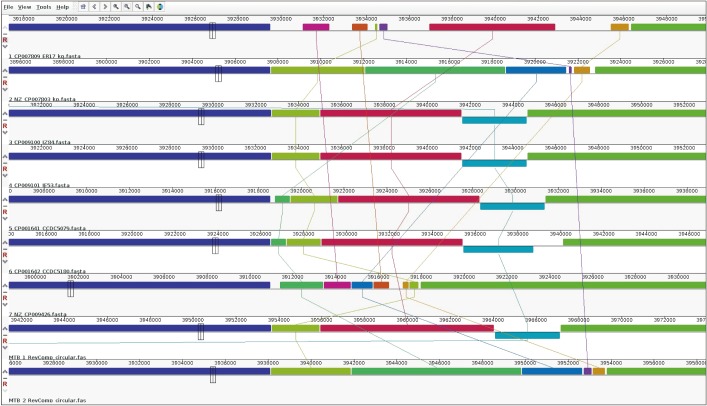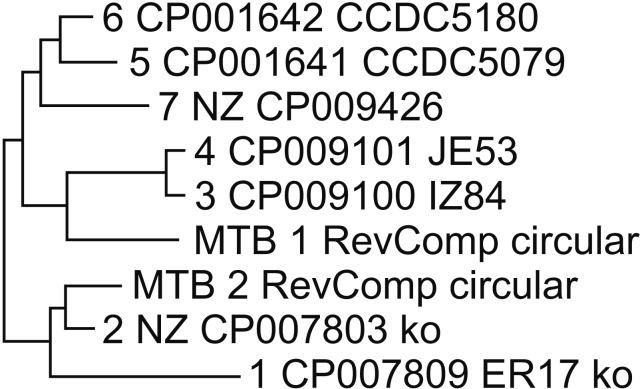Tuberc Respir Dis.
2018 Jul;81(3):216-221. 10.4046/trd.2017.0091.
Comparing Two Mycobacterium tuberculosis Genomes from Chinese Immigrants with Native Genomes Using Mauve Alignments
- Affiliations
-
- 1Clinical Research Centre, Masan National Tuberculosis Hospital, Changwon, Korea.
- 2LAS Inc., Gimpo, Korea.
- 3Division of Pulmonary, Sleep, and Critical Care Medicine, Department of Internal Medicine, Korea University Guro Hospital, Korea University College of Medicine, Seoul, Korea.
- 4Division of Pulmonary, Sleep, and Critical Care Medicine, Department of Internal Medicine, Korea University Ansan Hospital, Korea University College of Medicine, Ansan, Korea. lee-sh@korea.ac.kr
- KMID: 2414563
- DOI: http://doi.org/10.4046/trd.2017.0091
Abstract
- BACKGROUND
The number of immigrants with tuberculosis (TB) increases each year in South Korea. Determining the transmission dynamics based on whole genome sequencing (WGS) to cluster the strains has been challenging.
METHODS
WGS, annotation refinement, and orthology assignment for the GenBank accession number acquisition were performed on two clinical isolates from Chinese immigrants. In addition, the genomes of the two isolates were compared with the genomes of Mycobacterium tuberculosis isolates, from two native Korean and five native Chinese individuals using a phylogenetic topology tree based on the Multiple Alignment of Conserved Genomic Sequence with Rearrangements (Mauve) package.
RESULTS
The newly assigned accession numbers for two clinical isolates were CP020381.2 (a Korean-Chinese from Yanbian Province) and CP022014.1 (a Chinese from Shandong Province), respectively. Mauve alignment classified all nine TB isolates into a discriminative collinear set with matched regions. The phylogenetic analysis revealed a rooted phylogenetic tree grouping the nine strains into two lineages: (1) strains from Chinese individuals and (2) strains from Korean individuals.
CONCLUSION
Phylogenetic trees based on the Mauve alignments were supposed to be useful in revealing the dynamics of TB transmission from immigrants in South Korea, which can provide valuable information for scaling up the TB screening policy for immigrants.
MeSH Terms
Figure
Reference
-
1. World Health Organization. Global tuberculosis report 2016 [Internet]. Geneva: World Health Organization;2016. cited 2018 Jan 5. Available from: http://apps.who.int/iris/bitstream/10665/250441/1/9789241565394-eng.pdf?ua=1.2. Lee YK, Kwon YH, Lee SC, Sohn HJ, Koh YW. Overview of tuberculosis control and prevention polices in Korea. Public Health Wkly Rep. 2015; 8:651–656.3. Korea Centers for Disease Control and Prevention. Annual report on the notified tuberculosis in Korea. Cheongwon: Korea Centers for Disease Control and Prevention;2015.4. Min GH, Kim Y, Lee JS, Oh JY, Hur GY, Lee YS, et al. Social and clinical characteristics of Immigrants with tuberculosis in South Korea. Yonsei Med J. 2017; 58:592–597. PMID: 28332365.
Article5. Kim SJ, Bai GH, Lee H, Kim HJ, Lew WJ, Park YK, et al. Transmission of Mycobacterium tuberculosis among high school students in Korea. Int J Tuberc Lung Dis. 2001; 5:824–830. PMID: 11573893.6. Jeon CY, Kang H, Kim M, Murray MB, Kim H, Cho EH, et al. Clustering of Mycobacterium tuberculosis strains from foreign-born patients in Korea. J Med Microbiol. 2011; 60(Pt 12):1835–1840. PMID: 21799194.7. Jiang J, Gu J, Zhang L, Zhang C, Deng X, Dou T, et al. Comparing Mycobacterium tuberculosis genomes using genome topology networks. BMC Genomics. 2015; 16:85. PMID: 25766780.
Article8. Darling AC, Mau B, Blattner FR, Perna NT. Mauve: multiple alignment of conserved genomic sequence with rearrangements. Genome Res. 2004; 14:1394–1403. PMID: 15231754.
Article9. Bose M, Chander A, Das RH. A rapid and gentle method for the isolation of genomic DNA from mycobacteria. Nucleic Acids Res. 1993; 21:2529–2530. PMID: 8506155.
Article10. Eid J, Fehr A, Gray J, Luong K, Lyle J, Otto G, et al. Real-time DNA sequencing from single polymerase molecules. Science. 2009; 323:133–138. PMID: 19023044.
Article11. Chin CS, Alexander DH, Marks P, Klammer AA, Drake J, Heiner C, et al. Nonhybrid, finished microbial genome assemblies from long-read SMRT sequencing data. Nat Methods. 2013; 10:563–569. PMID: 23644548.
Article12. Koren S, Schatz MC, Walenz BP, Martin J, Howard JT, Ganapathy G, et al. Hybrid error correction and de novo assembly of single-molecule sequencing reads. Nat Biotechnol. 2012; 30:693–700. PMID: 22750884.
Article13. Park YK, Kang H, Yoo H, Lee SH, Roh H, Kim HJ, et al. Whole-genome sequence of Mycobacterium tuberculosis Korean strain KIT87190. Genome Announc. 2014; 2:e01103–e01114. PMID: 25359915.
Article14. Han SJ, Song T, Cho YJ, Kim JS, Choi SY, Bang HE, et al. Complete genome sequence of Mycobacterium tuberculosis K from a Korean high school outbreak, belonging to the Beijing family. Stand Genomic Sci. 2015; 10:78. PMID: 26473025.
Article15. Chen L, Zhang DT, Zhang J, Su YA, Zhang H. Whole-genome sequences of two clinical isolates of extensively drug-resistant Mycobacterium tuberculosis from Zunyi, China. Genome Announc. 2014; 2:e00910–e00914. PMID: 25237021.
Article16. Zhang Y, Chen C, Liu J, Deng H, Pan A, Zhang L, et al. Complete genome sequences of Mycobacterium tuberculosis strains CCDC5079 and CCDC5080, which belong to the Beijing family. J Bacteriol. 2011; 193:5591–5592. PMID: 21914894.17. Wan X, Qian L, Hou S, Drees KP, Foster JT, Douglas JT. Complete genome sequences of Beijing and Manila family strains of Mycobacterium tuberculosis. Genome Announc. 2014; 2:e01135–e01114.
Article
- Full Text Links
- Actions
-
Cited
- CITED
-
- Close
- Share
- Similar articles
-
- Molecular and genomic features of Mycobacterium bovis strain 1595 isolated from Korean cattle
- PrimateDB: Development of Primate Genome DB and Web Service
- The pattern of coding sequences in the chloroplast genome of Atropa belladonna and a comparative analysis with other related genomes in the nightshade family
- Detecting outliers in segmented genomes of flu virus using an alignment-free approach
- Transposable Elements: No More 'Junk DNA'



